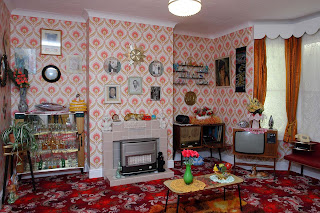The West Indian Front Room
The West Indian Front Room
The Visual Inspiration behind Let There Be Love
By Nirmala Nataraj
 |
| The West Indian Front Room exhibition at the Geffrye Museum, 2005-2006 Photo by John Neligan |
The exhibition’s curator, Michael McMillan,
describes the quintessential front room, which is derived from the Victorian
parlor: “colorful floral-patterned wallpaper and carpet that never matched, a
glass cabinet that displayed glass and chinaware you never used,
plastic-covered sofas, homemade crochet doilies, framed photographs . . . and
other elements that embodied the family’s aspirations, prescribed codes of
behavior, and moral values.” The exhibition itself included such memorabilia
alongside compelling first-hand narratives of West Indian immigrants.
McMillan, who is also a playwright and fine artist,
met Kwei-Armah in 1988. At the time, Kwei-Armah was acting in one of McMillan’s
plays, First Impressions. After this
creative collaboration, McMillan and Kwei-Armah kept in contact, although
McMillan was unaware that Kwei-Armah had seen The West Indian Front Room “until he told me it had inspired his
writing Let There Be Love,” recalls
McMillan. When McMillan saw Let There Be
Love during its inaugural run at London’s Tricycle Theatre in 2008, he “was
struck by how Alfred and his relationship with his home caregiver, Maria,
signified the shifting landscape of migration in British society,” he says.
McMillan, whose family hails from Saint Vincent and
the Grenadines, notes that the exhibition reveals the struggles and social
aspirations of the black diaspora. “For many of [the people in] their
generation, moving from living in one room to having a front room in a home of
their own was a sign that you had ‘made it.’ No matter who you were, if the
front room looked good, then your family was respectable.”
McMillan’s 2005–06 exhibition was well received by
black British audiences, as well as others from immigrant and working-class
backgrounds, ultimately garnering over 35,000 visitors. In 2009 The Front Room: Migrant Aesthetics in the
Home was published by Black Dog Publishing; it has been a reliable visual
reference for A.C.T.’s production of Let
There Be Love.
McMillan’s exploration of the importance of music
among London’s West Indian immigrants is also apparent throughout Let There Be Love. The key item of
furniture from the front room that Kwei-Armah decided to focus on is the “Blue
Spot” radiogram, a common feature in West Indian homes throughout Britain. The
radiogram usually included a radio and phonograph housed in a wooden cabinet,
sometimes with a drinks bar beneath it. Jazz, soul, ska, bluebeat (Jamaican
rhythm and blues), calypso, and reggae were imported in the form of seven-inch
vinyl records, which offered immigrants a sense of home “that they could listen
and dance to,” says McMillan.
McMillan and other cultural
commentators have suggested that the arrival of the television subverted the
formality of the front room and led to its eventual disappearance. “Many of my
parents’ generation have passed away, and their front room stuff has either
been dumped or been used in my exhibitions,” says McMillan.
Other West Indians have returned to their home
countries, taking with them the contents of their front rooms. However, one can
still occasionally find front rooms much like Alfred’s, where West Indian
elders cherish what they worked so hard to acquire.
For more about Let There be Love, be sure to read our latest edition of Words on Plays! Click here to order online.
For tickets to Let There be Love visit act-sf.org/love.

